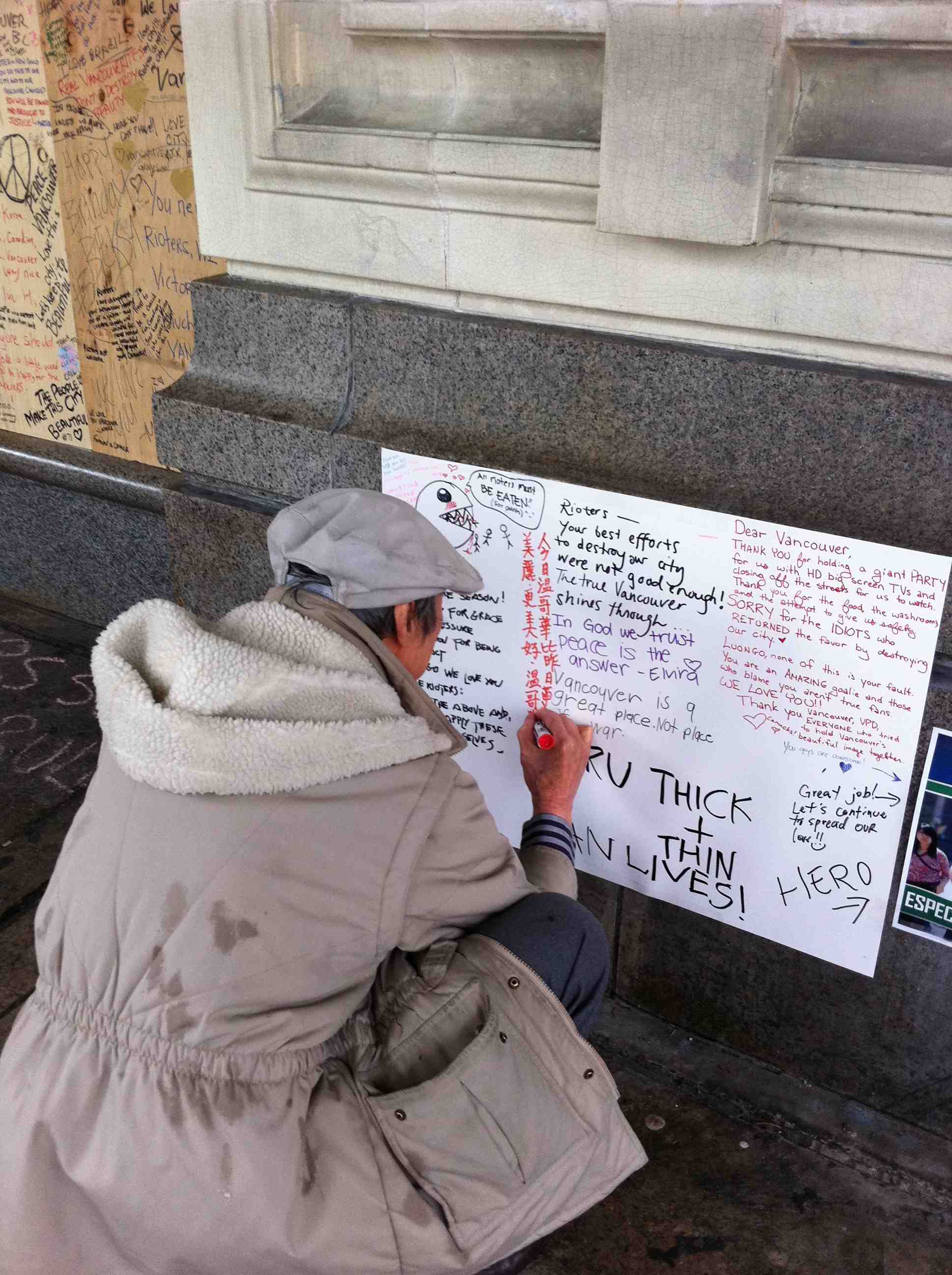Note to reader. I mention Wim Wender’s extraordinary 3D film on Pina Bausch in this piece. I was privileged to listen to Wenders give one of the greatest speeches of his life about his film at the Toronto International Stereoscopic 3D Conference in June of this year.
I have been thinking a lot about 3D over the last number of years not only because we at Emily Carr University have been doing some really interesting research into the craft and production of 3D films, but also because the reemergence of the medium is a function of a large number of cultural and technological variables that have come into play over the last decade.
These include, the miniaturization of screen real estate, motion capture technology that has made it far easier to integrate animation and live action, tablet computers and streaming technologies for the movies but also for independent film. Games, graphic simulations, and the Web are all to varying degrees implicated in the interest that creators and viewers are showing in 3D. This has largely to do with the fact that 2D is so omnipresent that the desire to break through 2D space has increased and with some intensity. That effort is well represented in the Wii and the Kinect.
The ways in which we manage information and the ways in which we create information within social and other media are also part of this shift. The context is then both particular and related to the present. 3D is back because we NEED it as a way of rediscovering embodiment in a world driven by data based systems.
So, let me comment on a few of these elements as a way of stimulating some discussion around the following question: Does 3D challenge the fundamental assumptions that have always existed in the production and viewing of the narrative, documentary and experimental cinema? I think that Wim Wenders has tried to answer at least part of that question with his 3D film on Pina Bausch.
A couple of observations. 3D is not significantly more interactive than 2D cinema. Greater depth produced through the many layers that make 3D possible does however affect the space for cinematic exhibition and exposition and concurrently the space for audience participation. Metaphorically, 3D expands the possible range of audience interactions, although still within the confines of the screen and conventional audience seating configurations.
I am talking here about cinema theatres and in general my comments do not reference caves and other performance spaces or installations, which use physical structures and specialized technologies to generate the illusion of participation.
However, the amplification of the visual field in 3D needs to be examined in the context of further discussions on the kinesthetic effects of viewing with glasses and without, an area that I will not touch on here. The interactions when they do occur in 3D are in the visceral reaction to movement and the exploration of the visual field. 3D is often discussed as if it creates a greater sense of tangibility as well as ‘optical’ and haptic feedback.
I believe that we have to test these assumptions with more rigour than we have up until now. I would argue in a similar vein that console based games which supposedly allow players to maintain greater control over the game or the narrative are really a variation on the display traditions of conventional television than a truly interactive process. Tangibility and feedback come from the process of co-creation, a point to which I will return to in a moment.
The ‘presence’ of 3D images, their force also comes from a combination of increased intensity produced through a heightened sense that the illusory space of 2D has finally been cracked. This is aided by sound augmented by the use of special effects. Wenders’ Pina Bausch film is extraordinary and beautiful but was produced using a set of very sophisticated and costly technologies. This is not a criticism, but is more of a reflection on the challenges that lie ahead.
We talk about special effects as a function of screen technology and for the most part it is. But, special effects are also content at all levels. 3D paves the way I would suggest, for a shift in viewing experiences that is somewhat akin to hyperlinking in conventional uses of the web and touch screen controls on the iPad — another couple of points that I will come back to in a moment.
When I say that special effects are content, it is not so much what narratives are doing with special effects, but more importantly that special effects are an important component of the story and I would argue that is maintained in Wenders’ film.
Take the recent 3D production of Alice in Wonderland for example. Alice’s imaginary is the site for all sorts of special effects from physical size to animal intelligence. The narrative explores these transformations both from within its own assumptions and through the force applied by the use of the special effects. The depth of the effects, their strength comes from opening up a space for viewing that allows the special effects to at times overwhelm the mise-en-scène and become the story.
I would propose that 3D cinema is about exploring not only the layers that make it possible, but also the interaction of space and effects with depth and crucially the distribution of information across those layers.
Distribution across conventional screen real estate is driven by narrative (even in the documentary film) and is changed in 3D to information scattered across large spaces that requires scanning, viewing and continual adjustment to spatial and temporal shifts. In 3D the frame surrounding the image becomes leaky and that fluidity redistributes the visual field. The result is not perspective in the conventional sense, but something akin to telescopic vision.
Special effects as data. Distribution, as James Cameron discovered requires very, very complex technologies because data needs many layers of physical and digital sculpting to move from its status as information to something resembling a body or a hybrid or a landscape (especially as Cameron is equally driven by the need to generate intensely realistic visualizations of his imaginary worlds).
There has been a great deal of discussion about the technologies needed to make 3D work but as we know some of the key technologies have been in existence for some time. The difference now is that we are all involved in manipulating distributed forms of information and have become accustomed to at least trying to penetrate the many screens we use on an everyday basis. We also struggle with information flow. Notwithstanding our efforts to try and aggregate or curate the information, there is always some more data on the horizon. This struggle is one reason why 3D technologies seem to offer a way out of the maze that our continual interaction with the 2D world has created for us. As we move closer to the time when we will not need glasses to view 3D, we must ask more questions about 2D.
I was asking myself the other day whether Robert Bresson would ever have been interested in making a 3D film? For those of you who may know his work, it is by modern standards excruciatingly slow both in the mise-en-scène and in the development of the narrative. The early films of Alain Resnais were quite similar to Bresson’s. Many of the experimental films of the early 1970’s experimented with time trying to understand its role in the viewing experience by creating static shots driven by voice more than by action on the screen.
I would suggest in reference to an earlier comment, that 3D films by virtue of their technological impulses create spaces of description and narrative that require movement, constant movement. And, ironically that is the very nature of the Web as seen in 2D on a computer or smart phone. I see hyperlinking as a metaphor for movement where no one piece of information suffices and where nothing can really stand on it own.
The relationships between screen and reality have receded with the boundaries less and less clear and crucially less visible. Metaphorically, as the screen tries to break out of its confines, the space for exhibition shifts into the wonderful yet illusory middle space between screen and viewer, like our hands that want to reach out to touch the miniaturized Bono on a stage in Buenos Aires in the amazing film made about his concert. This middle space is also a middle ground but it is not a place you can plant your feet into and the question that then arises is whether 3D is itself misnamed.
Or, has the human body been transformed into a screen and we are merely exploring its vicissitudes as our imagined and holographic selves search for some common ground? I would remind everyone that all cinema is about dematerialization.
Bono’s dematerialized self sits in my mind as an idealized version, Bono 6.4 like some sort of operating system that has moved from its status as manager to an invisible mediator of what we do with computers. But the thing about that film is not Bono, but the audience and their movements, joy and sheer sense of being, something we can only witness as viewers, but something we nevertheless want to share.
It is not an accident then that Avatar is about replacement and substitution at all levels from prosthetics to the final conversion of death from decay into life. Cameron unlike Werner Herzog intuitively understands that screens will not do and even 3D cannot replace the need for language. This is why Cameron not only invents a new world but creates a specialized language for it. And, so much of the film centres on translation not only between machines but also between hybrids and humans.
And so, what did I mean by my comment about co-creation? Well, so much of the rhetoric around 3D and gaming is about enhanced experiences produced through technological innovation and some of that is fair and right. But, much of it is still steeped in representational strategies that don’t allow for shared control.
Co-creation implies distributed responsibilities and a sharing of the outcomes, something that Pina Bausch understood because so much of her work in its abstractness and visual metaphors opens up a space for audiences to project their needs, feelings and fears onto the performers. Her space is the stage and as with all stages we witness what happens in 3D but we also create what we see and this is fundamental to all forms of media but is often drowned out in the effort to ‘produce’ the ideal spectator.
I was overwhelmed by the images from Wender’s film which will be released in North America in the Fall of 2011. But, we need to keep in mind that his work told us a series of brilliant, poignant stories that took the viewing of the film from its normal theatrical confines into the shared relationship we developed with a dazzling and articulate artist. He is the ultimate auteur! He and not the film turned the theatre into a small coffee shop and as we sat around the table and listened to this consummate storyteller, we translated that intimacy into the images he showed us. He opened up a space where we could share his life. Could a 3D film of the speech that he gave have done the same thing?
 Sunday, September 11, 2011 at 7:10PM
Sunday, September 11, 2011 at 7:10PM 




